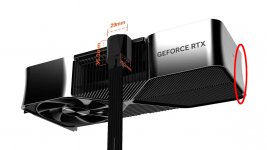CableMod has announced its 12VHPWR right-angle adapter, an accessory that might be of interest to early GeForce RTX 4090 adopters who are seeking a cleaner-looking profile.
Go to post
Go to post
Seems to alleviate the cable strain issues some would suffer otherwise.

I've found that I prefer the 180 degree adapters for the eight-pin PCIe connectors. You wind up running the cables right down the backside of the PCB, typically straight into a cable management cutout.If I had my druthers, I'd want the power connector somewhere where I can easily route it behind the motherboard tray through a passthrough without it being in the way.
Agreed.
I still think that is the dumbest power connector location I've ever seen.
If I had my druthers, I'd want the power connector somewhere where I can easily route it behind the motherboard tray through a passthrough without it being in the way.
I'm thinking bottom of the back of the card. Here:
View attachment 1973
Then you could just poke it through one of the cable passthroughs and route it mostly unseen.
Only because the PCBs were designed assuming the power connection would come in on top. Moving the power connection isn't trivial, it would require a lot of things to be moved around, but if you were looking at a high level at how the card would be used and installed; you'd think engineers would consider things like this and design towards better solutions.there is no PCB at that side
Same acronym as nVidia's, but it stood for "Scan Line Interleave" instead of nVidia's "Scalable Link Interface."whatever 3dfx called it
My EVGA GeForce 7900 GT was like that (and the GeForce 7950 GT that replaced it via RMA), as well as my EVGA GeForce 8800 GT AKIMBO. It was annoying because in those days with the midtower I had (Thermaltake Tsunami Dream), I had to snake the PCIe power cables through the HDD cage, between two HDDs. There was just barely enough room to plug in the cables without the HDD cage's frame interfering.I can't find any photos but I seem to recall when cards started requiring extra power, most of them did have connections along the rear edge
Same acronym as nVidia's, but it stood for "Scan Line Interleave" instead of nVidia's "Scalable Link Interface."
Which we saw plenty of at my last job at a freelance software QA company where we tested nVidia drivers and GPUs. nVidia never cared much for SFR.Unfortunately most titles were designed with just the one render mode in mind, and it was built into game profiles, and that was AFR. You could force the mode in settings if you preferred SFR, but it was unpredictable and could result in crashing, graphics bugs and other problems, because the drivers had been optimized for each particular game with the mode built into the profile in mind.
